
So, you’ve got a dishwasher. Nice. Modern convenience, fewer fights about dishes, and way less wrinkly hands. But wait—your dishwasher’s not exactly… staying put? It’s wobbling, tipping forward, or doing that weird shimmy every time you open the door?
Yeah, that’s where the mounting bracket comes in.
Don’t worry if you’re sitting there like, “What even is a mounting bracket?” You’re not alone. A lot of people install dishwashers thinking they’re good to go, then find out their shiny new appliance is doing the electric slide every time they load a plate.
Let’s fix that. Together. No complicated jargon, no hardware store panic attacks. Just a simple, chill walkthrough to get that dishwasher locked in like a pro.
So, What’s This Bracket Thing Anyway?
Alright, quick rundown: a dishwasher mounting bracket is this little metal piece (or sometimes plastic) that basically screws the dishwasher to either your countertop or the side cabinets. Think of it like a seatbelt for your dishwasher—it keeps everything in place when the door drops down or when you’ve got a heavy load in the bottom rack.
Without it? Your dishwasher could literally tip forward. And let me tell you, nothing says “danger” like a half-loaded dishwasher trying to swan-dive into your kitchen floor.
So yeah, it’s a tiny part, but kinda a big deal.
What You’ll Need Before You Start (a.k.a. Grab This Stuff First)
Okay, let’s not play the “Oops I forgot that tool” game five times. Here’s what you’re gonna want to have on hand before you crawl under the countertop:
- The mounting bracket kit (usually comes with the dishwasher, but if it didn’t… Amazon’s your friend)
- Screwdriver or drill
- Screws (again, should come in the kit)
- A flashlight or headlamp (because it will be dark under there)
- Maybe a towel, because you’re totally gonna kneel on something cold and unforgiving
Bonus: if you’re reinstalling an old dishwasher, you might need a putty knife to remove old gunk or leftover brackets.
Alright, got your stuff? Perfect.
Step 1: Figure Out Where You’re Mounting This Thing
Alright, decision time.
You’ve got two main options here, and it really depends on your setup:
- Top-mount: Brackets attach to the underside of your countertop (common with wood or laminate countertops).
- Side-mount: Brackets screw into the side cabinets (used when the countertop is granite or something you really don’t wanna drill into).
Quick tip: Most brackets are convertible, so you can bend or snap them depending on how you’re mounting. Check the little instruction slip in the kit—or, you know, wing it carefully while comparing it to the dishwasher.
Step 2: Slide Out the Dishwasher (Just a Little)
Okay, here comes the mildly awkward part.
You’ll need to pull the dishwasher out a few inches from under the counter to get to the top or sides. Not all the way—just enough so you can reach the mounting spots and line things up.
Before you tug on it like you’re moving a fridge, do a quick check:
- Is it still plugged in?
- Is the water line flexible enough to give you some wiggle room?
- Is the drain hose long enough not to yank out when you move it?
If yes, cool. Slide it forward a bit. If not… well, you might have to disconnect stuff. Not the end of the world, just an extra step.
Once you’ve got it scooted out, you’ll see a metal frame near the top (or sides, if you’re side-mounting). That’s your target zone.
Step 3: Attach the Mounting Brackets to the Dishwasher
Here’s where things start to feel productive.
Take those little metal brackets and line them up with the slots or screw holes on the dishwasher frame. You’ll usually see a place to slide them in or bend a tab into position—don’t overthink it. They’re made to only go in one or two ways.
Now, grab your screwdriver (or drill if you’re feeling powerful) and secure the brackets into place. Some dishwashers even have pre-drilled holes or notches to make this foolproof. Love that.
Pro Tip: Make sure the bracket ends are pointing the right way—up if you’re top-mounting, out to the sides if you’re going the cabinet route. It’s way easier to double-check now than after you’ve shoved the dishwasher back in.
Step 4: Slide the Dishwasher Back and Screw It In
Okay, deep breath—you’re in the home stretch.
Now that your brackets are attached, gently slide the dishwasher back into place. Try not to crimp any hoses or pinch wires while you’re at it (seriously, that stuff can be annoying later). Use that flashlight if needed to check underneath.
Once it’s lined up and flush with the cabinets, open the door and look at the bracket ends. You should see them peeking out from under the countertop or inside the cabinet walls.
Grab your screws and lock that baby in. Two screws—one on each side or both on top, depending on your bracket setup—and boom. That dishwasher’s going nowhere.
Test it by opening the door. Does the whole thing lurch forward like it’s trying to escape? No? You did it right.
Step 5: Final Checks & Tiny Tweaks
Alright, so you’ve got the dishwasher back in place, brackets screwed in tight, and everything seems… pretty solid. Nice work! But before you start patting yourself on the back (which you totally should do soon), let’s run through a few quick sanity checks:
🔹 Is it level?
Open the dishwasher door and pull out the bottom rack. If it rolls out super fast or doesn’t come out at all without a fight, your dishwasher might be tilted. You can adjust the little feet underneath to even things out—just twist them like little dials until the unit sits straight. Use a level if you’ve got one, or just trust your eyeballs. Either works.
🔹 Are the brackets tight?
Give the dishwasher a gentle tug. Not a full-on Hulk yank—just a light pull. If it doesn’t budge? You’re golden. If it wiggles? Might wanna re-check those screws.
🔹 Any weird gaps?
Sometimes after sliding it back in, you’ll see a small space between the dishwasher and the counter or cabinets. Totally normal. But if it’s bugging you, there are trim kits and filler panels for that.
Bonus Tip: Trim the Bracket Tabs If They Stick Out
This one’s optional, but it’s a nice little finishing touch.
Sometimes, after you screw the bracket in, a little metal tab is still sticking out past the cabinet line or above the countertop. You can leave it (no big deal), but if it bugs you, just grab a pair of metal snips and trim it off. Then pat yourself on the back again for going the extra mile.
You’re Done! 🎉
And just like that—you installed a dishwasher mounting bracket without throwing tools, yelling at your kitchen, or calling your cousin who “sorta does handyman stuff.” That’s a win in my book.
Now your dishwasher is locked in, sturdy, and ready to tackle mountains of dishes without wobbling like it’s had one too many. You did that. You.
Go ahead and run a quick cycle just to double-check that everything’s working. Listen for any weird noises (there shouldn’t be any). And hey, while that’s running? Maybe reward yourself with a snack. Or a nap. You earned it.
Got another DIY mystery you want cracked wide open? I’m all ears. Until then—happy dishwashing, champ. 🧼✨
